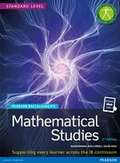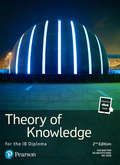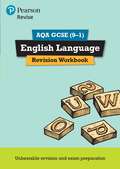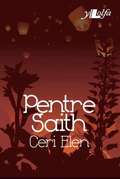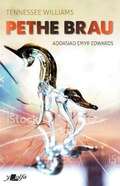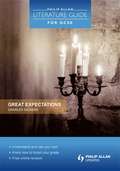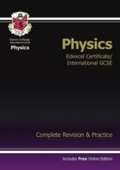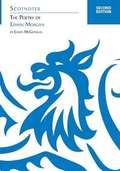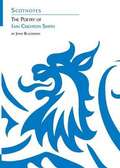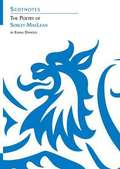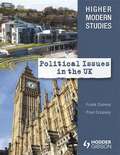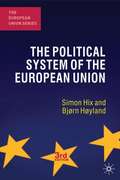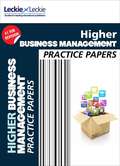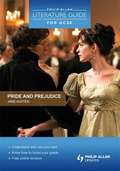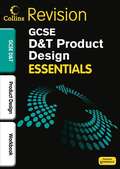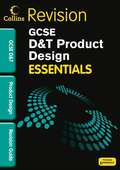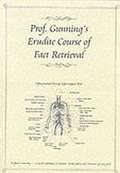- Table View
- List View
Pearson Education Baccalaureate Mathematical Studies Print and Ebook Bundle for the IB Diploma 2012 (2nd edition) (PDF)
by David Wees Ron Carrell Roger BrownCombined with enhanced online eBook access and free additional resources, Pearson Education Baccalaureate Mathematical Studies 2nd edition is a complete offering for the IB diploma. Written by experienced IB practitioners, it covers everything you need to study for the latest Mathematical Studies syllabus.
Pearson Education Baccalaureate Theory of Knowledge Print and eBook Bundle for the IB Diploma: Industrial Ecology (Pearson International Baccalaureate Diploma: International Editions)
by Sue BastianCombined with enhanced online eBook access, Pearson Education Baccalureate Theory of Knowledge 2nd Edition is a complete offering for the IB Diploma. Written by experienced IB practitioners, it covers everything you need to study for the latest Theory of Knowledge syllabus and will also help you to prepare thoroughly for your Prescribed Essay and Student Presentation. Provides comprehensive coverage of the new Knowledge Framework and additional Areas of Knowledge. Includes new chapters on religious and indigenous knowledge as a way to enrich the concepts of knowledge and international-mindedness. Enables clear links to the Learner Profile, and to the various components of the IB Diploma programme. Offers assessment opportunities using past Prescribed Essay titles. Teaches you how to prepare and evaluate your work, including the Prescribed Essay and Student Presentation. The Pearson Education Baccalaureate series includes many more titles, across the entire IB continuum. Visit www.Pearson Educationbaccalaureate.com for a complete list.
Pearson REVISE AQA GCSE: Revision Workbook (REVISE AQA GCSE English 2015)
by Jonathan Morgan Julie Hughes David GrantPearson Revise is the revision series from Pearson, the assessment experts. From the very start of your GCSE, Pearson Revise is the best way to keep learning up to date, practise skills and prepare for assessments and exams. Our Revision Workbooks help students develop vital skills throughout the course in preparation for the exam with: one-to-one page match with the revision guide so students can find the practice they need quickly and easily guided practice questions on every page demonstrate good technique and build confidence loads of practice questions in the style of the new exams, with plenty of practice at problem-solving and reasoning skills hints and tips help students avoid common pitfalls full set of practice papers written to match the new specification exactly. Part of a comprehensive range of learning and revision support available for Pearson Edexcel and AQA GCSEs from Pearson Revise including: Revision Guides, Revision Workbooks, Revision Cards, Practice Papers Plus and a free online learning portal.
Pentre Saith (Cyfres y Dderwen)
by Ceri MorrisCain yw'r prif gymeriad ac mae'r 'saith' yn y teitl yn cyfeirio at Saith Rhyfeddod Naturiol y Byd a Saith Oes Galar. Arddull ffres, newydd gan awdur ifanc. [Cain is the main character in this novel, and the 'saith' (seven) in the title refers to the Seven Wonders of the Natural World and the Seven Ages of Grief.] *Datganiad hawlfraint Gwneir y copi hwn dan dermau Rheoliadau (Anabledd) Hawlfraint a Hawliau mewn Perfformiadau 2014 i'w ddefnyddio gan berson sy'n anabl o ran print yn unig. Oni chaniateir gan gyfraith, ni ellir ei gopïo ymhellach, na'i roi i unrhyw berson arall, heb ganiatâd.
Periodic table (Large Print - colour)
by RnibThis is a multi-page document showing the periodic table of chemical elements, and on the Large Print version, a key to the table. The LP key is on the first page. The table is in five parts, which can be joined together. There is a locator dot and title shown on each page. These will be at the top left of the page when it is the correct way up. This is a complex diagram and blind and partially sighted people may find it helpful to have some sighted assistance at first viewing. The table shows element categories (in large print only), groups (families) and periods, plus the atomic number, the chemical symbol and atomic weight for each element. Key to Large Print periodic table - The key to the table shows the colours used to represent the element categories, and is arranged in two columns. In each column, the colour samples are to the left with their names to the right. The categories are not shown on the tactile version of the table, as there is insufficient space in the cells for textures. It is recommended that you download the Periodic table overview from the ImageShare site, as this shows the element categories in tactile format. Periodic tabl The table comprises cells arranged in columns and rows. A cell shows the atomic number, chemical symbol and atomic weight for an element. In the Large Print version of the table, the cell colour relates to the element category as shown on the key. The vertical columns show the groups (or families) of elements. The groups are numbered across the top of the page. A horizontal row in the table is a period. The periods are numbered on the left side of the first page of the table. In this arrangement of the periodic table, the lanthanoids and actinoids (periods 6 to 7, known as the f-block) are separated from the other elements and are shown stretching across the bottom of the page. The f-block on pages 3, 4 and 5 has no periodic numbers marked on the page. Joining the page - To allow space for braille labelling, this table has been split into five sections on separate pages. Join them to each other in number order, from left to right, trimming the periodic numbers as required. Pages 1 and 5 are A4 size and in portrait orientation. Pages 2 to 4 are A3 size and in landscape orientation. Trim the pages to allow joining, using the light, vertical dashed grid lines as guides. When joining the tactile pages, care should be taken to avoid covering any part of the table.
Periodic table overview (Large Print)
This is an overview to the periodic table with an accompanying key. It is a multi-page image set on two pages. There is a locator dot shown, which will be at the top left of the page when the image is the correct way up. The table shows element categories, groups and periods. Key to periodic table overvw - The textures/colours used on the overview to the periodic table of elements are shown in two columns. The texture/colour examples representing the element categories are labelled to the right. The same colours are also used on the full-sized periodic table mentioned above. Periodic table overvw The vertical columns show the groups (families) of elements. The groups are numbered across the top of the page. A horizontal row in the table is a period. The periods are numbered at the left of the page. In this arrangement of the periodic table, the lanthanoids and actinoids (the f-block) are separated from the other elements and are shown stretching across the bottom of the page. Full-size table A full-size version of the table is also available. It shows the element categories (in Large Print only), groups and periods, plus the atomic number, the chemical symbol and atomic weight for each element.
Periodic table overview (UEB Contracted)
by RnibThis is an overview to the periodic table with an accompanying key. It is a multi-page image set on two pages. There is a locator dot shown, which will be at the top left of the page when the image is the correct way up. The table shows element categories, groups and periods. Key to periodic table overvw - The textures/colours used on the overview to the periodic table of elements are shown in two columns. The texture/colour examples representing the element categories are labelled to the right. The same colours are also used on the full-sized periodic table mentioned above. Periodic table overvw The vertical columns show the groups (families) of elements. The groups are numbered across the top of the page. A horizontal row in the table is a period. The periods are numbered at the left of the page. In this arrangement of the periodic table, the lanthanoids and actinoids (the f-block) are separated from the other elements and are shown stretching across the bottom of the page. Full-size table A full-size version of the table is also available. It shows the element categories (in Large Print only), groups and periods, plus the atomic number, the chemical symbol and atomic weight for each element. Additional note: embossed .brf Periodic table is available at; https://www.rnibbookshare.org/cms/braille-teaching-resources
Periodic table overview (UEB Uncontracted)
This is an overview to the periodic table with an accompanying key. It is a multi-page image set on two pages. There is a locator dot shown, which will be at the top left of the page when the image is the correct way up. The table shows element categories, groups and periods. Key to periodic table overvw - The textures/colours used on the overview to the periodic table of elements are shown in two columns. The texture/colour examples representing the element categories are labelled to the right. The same colours are also used on the full-sized periodic table mentioned above. Periodic table overvw The vertical columns show the groups (families) of elements. The groups are numbered across the top of the page. A horizontal row in the table is a period. The periods are numbered at the left of the page. In this arrangement of the periodic table, the lanthanoids and actinoids (the f-block) are separated from the other elements and are shown stretching across the bottom of the page. Full-size table A full-size version of the table is also available. It shows the element categories (in Large Print only), groups and periods, plus the atomic number, the chemical symbol and atomic weight for each element.
Periodic table (UEB Contracted)
This is a multi-page document showing the periodic table of chemical elements, and on the Large Print version, a key to the table. The LP key is on the first page. The table is in five parts, which can be joined together. There is a locator dot and title shown on each page. These will be at the top left of the page when it is the correct way up. This is a complex diagram and blind and partially sighted people may find it helpful to have some sighted assistance at first viewing. The table shows element categories (in large print only), groups (families) and periods, plus the atomic number, the chemical symbol and atomic weight for each element. Key to Large Print periodic table - The key to the table shows the colours used to represent the element categories, and is arranged in two columns. In each column, the colour samples are to the left with their names to the right. The categories are not shown on the tactile version of the table, as there is insufficient space in the cells for textures. It is recommended that you download the Periodic table overview from the ImageShare site, as this shows the element categories in tactile format. Periodic tabl The table comprises cells arranged in columns and rows. A cell shows the atomic number, chemical symbol and atomic weight for an element. In the Large Print version of the table, the cell colour relates to the element category as shown on the key. The vertical columns show the groups (or families) of elements. The groups are numbered across the top of the page. A horizontal row in the table is a period. The periods are numbered on the left side of the first page of the table. In this arrangement of the periodic table, the lanthanoids and actinoids (periods 6 to 7, known as the f-block) are separated from the other elements and are shown stretching across the bottom of the page. The f-block on pages 3, 4 and 5 has no periodic numbers marked on the page. Joining the page - To allow space for braille labelling, this table has been split into five sections on separate pages. Join them to each other in number order, from left to right, trimming the periodic numbers as required. Pages 1 and 5 are A4 size and in portrait orientation. Pages 2 to 4 are A3 size and in landscape orientation. Trim the pages to allow joining, using the light, vertical dashed grid lines as guides. When joining the tactile pages, care should be taken to avoid covering any part of the table.
Periodic table (UEB Uncontracted)
by RnibThis is a multi-page document showing the periodic table of chemical elements, and on the Large Print version, a key to the table. The LP key is on the first page. The table is in five parts, which can be joined together. There is a locator dot and title shown on each page. These will be at the top left of the page when it is the correct way up. This is a complex diagram and blind and partially sighted people may find it helpful to have some sighted assistance at first viewing. The table shows element categories (in large print only), groups (families) and periods, plus the atomic number, the chemical symbol and atomic weight for each element. Key to Large Print periodic table - The key to the table shows the colours used to represent the element categories, and is arranged in two columns. In each column, the colour samples are to the left with their names to the right. The categories are not shown on the tactile version of the table, as there is insufficient space in the cells for textures. It is recommended that you download the Periodic table overview from the ImageShare site, as this shows the element categories in tactile format. Periodic tabl The table comprises cells arranged in columns and rows. A cell shows the atomic number, chemical symbol and atomic weight for an element. In the Large Print version of the table, the cell colour relates to the element category as shown on the key. The vertical columns show the groups (or families) of elements. The groups are numbered across the top of the page. A horizontal row in the table is a period. The periods are numbered on the left side of the first page of the table. In this arrangement of the periodic table, the lanthanoids and actinoids (periods 6 to 7, known as the f-block) are separated from the other elements and are shown stretching across the bottom of the page. The f-block on pages 3, 4 and 5 has no periodic numbers marked on the page. Joining the page - To allow space for braille labelling, this table has been split into five sections on separate pages. Join them to each other in number order, from left to right, trimming the periodic numbers as required. Pages 1 and 5 are A4 size and in portrait orientation. Pages 2 to 4 are A3 size and in landscape orientation. Trim the pages to allow joining, using the light, vertical dashed grid lines as guides. When joining the tactile pages, care should be taken to avoid covering any part of the table. Additional note: embossed .brf Periodic table is available at; https://www.rnibbookshare.org/cms/braille-teaching-resources
Pethe Brau
by Tennessee Williams Emyr Edwards"The Glass Menagerie" yw un o ddramâu llwyddiannus cyntaf Tennessee Williams. Ac er i'w chefndir fod yn estron i Gymru, mae ei phwnc yn dragwyddol ei apêl. Prif thema Tennessee Williams yn ei holl ddramâu (a thybed nad hon yw prif thema pob llenor yn y bôn?) yw'r gwahaniaeth rhwng rhith a phethau'n union fel y maent. Rydym ni i gyd yn byw'n foethus yn ein dychymyg, ac yna daw bywyd bob dydd, a hynny'n greulon, i roi ysgytfa ddidostur inni a gwneud hwyl am ein pennau. Dyna yw'r ddrama hon - stori am gariad sy'n wefr yn y dychymyg, ac eto'n ddim ond rhith i'w ddistrywio gan bethau fel y maent - peth brau nad oes dim yn ei aros ond cael ei dorri. [Translation of one of Tennessee Williams' first successful plays, "The Glass Menagerie".]
Philip Allan Literature Guide for GCSE: Great Expectations (PDF)
by Peter Morrisson Charles DickensFor study or revision, these guides are the perfect accompaniment to the set text, providing invaluable background and exam advice. Philip Allan Literature Guides (for GCSE) offer succinct and accessible coverage of all key aspects of the set text and are designed to challenge and develop your knowledge, encouraging you to reach your full potential. Each full colour guide:- Gives you the confidence that you know your set text inside out, with insightful coverage for you to develop your understanding of context, characters, quotations, themes and style. Ensures you are fully prepared for your exams: each guide shows you how your set text will be measured against assessment objectives of the main specification. Develops the skills you need to do well in your exams, with tasks and practice questions in the guide.
Physics: Complete Revision and Practice (PDF)
by Cgp BooksThis CGP Complete Revision Practice book is a superb way for students to prepare for the Edexcel Certificate / International GCSE Physics exams. It explains every topic from the course with clear, concise study notes and full-colour diagrams - and at the end of each section, there's a generous selection of exam-style questions to help hone their skills for the final tests (with answers included).
Physics Questions for CCEA GCSE
by Roy WhiteProvides banks of questions to address the requirements of the revised CCEA GCSE Physics specification and covers both the full Physics course and the Physics component of Double Award Science. Questions are entirely new, not from past papers and suitable for use as classroom material, for use in homework and to assist with revision. Includes an indication of whether each question is appropriate for the foundation tier and/or higher tier. The author, Roy White, is a highly reputable author and will be well known to teachers in Northern Ireland. To encourage the students’ work answers will not be printed in the rear of the book. Full set of answers, including the process where appropriate available via this link: http://www.colourpointeducational.com/media/content/PhysicsGCSEAnswers.pdf
The Poetry Of Edwin Morgan (Scotnotes Study Guides #2)
by James McGonigalEdwin Morgan (1920–2010) is one of the giants of modern poetry. Scotland’s national poet from 2004 to his death in 2010, he produced an astonishing range of work, from the playful to the profound. James McGonigal’s Second Edition of this Scotnote (2013) covers the entirety of Morgan’s work throughout the poet’s long and hugely productive life, and is an ideal guide for senior school pupils and students to Morgan’s overflowing creativity.
Poetry Of Iain Crichton Smith (Scotnotes Ser. #No. 8)
by John BlackburnIain Crichton Smith was one of the foremost poets of the 20th century, writing in English and Gaelic. His poetry often concerns itself with unsentimental views of life in the Western Highlands and Islands, and his dislike of, and opposition to, dogmatic authority. John Blackburn’s Scotnote analyses the religious, political and historical themes and patterns of Crichton Smith’s work, and is a suitable guide for senior school pupils and students at all levels.
The Poetry Of Sorley Maclean (Scotnotes Ser. #30)
by Emma DymockAlong with his contemporaries Edwin Morgan and Hugh MacDiarmid, Sorley MacLean is recognised as one of the most important Scottish poets of the twentieth century. Born at Oscaig on the island of Raasay in 1911, MacLean was greatly influenced by Gaelic tradition and by contemporary cultural and political ideas from around the world. In many ways he brought Scottish Gaelic poetry into the modern era, and he is a key figure in modern Scottish literature. MacLean’s poetry ranges beyond Scotland to confront European and world events and politics. This book offers a detailed study of MacLean’s poems, providing insight into the context of his work. It also includes close readings of selected poems that best represent his key themes and ideas. This Scotnote is ideal for senior school pupils and students of all ages as a general introduction or as a starting point for more in-depth study.
Political Issues In The UK (Hodder Gibson Modern Studies (PDF))
by Frank Cooney Paul CreaneyHigher Modern Studies: Political Issues in the UK provides up-to-date, accessible and in-depth content of the key issues surrounding the electoral systems and decision-making of the Scottish and UK parliaments. Activities and exam questions are included regularly to improve your skills and develop your confidence in tackling the assessment demands of this compulsory study theme in the SQA course. Higher Modern Studies: Political Issues in the UK: is written specifically to cover the three most popular content areas of this study theme and includes full coverage of the 2010 General Election and 2011 Scottish election results brings complex statistics and ideas to life with an accessible writing style, attractive full colour design and informative illustrations contains helpful summaries, key points and case studies to consolidate knowledge and understanding of the key topic elements offers realistic exam practice activities to effectively prepare students for the essay-based demands of Paper 1
The Political System Of The European Union (PDF)
by Simon Hix Bjørn HøylandSystematically revised and rewritten throughout and updated to cover the impact of the Lisbon Treaty, this highly-successful and ground-breaking text remains unique in analyzing the EU as a political system using the methods of comparative political science.
Powell
by Manon Steffan RosMae bod yn Powell yn fraint yn Nhrefair, ac mae Elis Powell, 15 oed, yn falch o'i gyndaid a adeiladodd gymaint o'r dref. Ond pan aiff Elis a'i daid ar drip i'r Unol Daleithiaui hel achau, maen nhw'n dod i wybod llawer mwy am hanes eu teulu, ac mae bod yn Powell yn sydyn yn teimlo fel baich... Nofel am deulu, cyfeillgarwch a phwysigrwydd cydnabod y ffeithiau i gyd. [This novel about the relationship between a grandfather and his grandson touches on Wales's relationship with slavery, and discusses how to acknowledge the horrors of history in a sensitive way. After exploring the family's ancestry, Elis and Taid journey to Virginia, USA to tread in the footsteps of Edward Powell.]
Practice papers for SQA exams: CfE higher business management (PDF)
by Rob JacksonCfE Higher Business Management Practice Papers will help you to prepare for the look and feel of the exam. All the papers will provide extensive practice and reflect the type and level of questions students are likely to meet; the formats of different question papers and assessment methods; and the type of marking schemes used by the SQA.
Pride and Prejudice (Philip Allan Literature Guide For GCSE) (PDF)
by Jane Austen Shelagh HubbardFor study or revision, these guides are the perfect accompaniment to the set text, providing invaluable background and exam advice. Philip Allan Literature Guides (for GCSE) offer succinct and accessible coverage of all key aspects of the set text and are designed to challenge and develop your knowledge, encouraging you to reach your full potential. Each full colour guide:-nbsp; Gives you the confidence that you know your set text inside out, with insightful coverage for you to develop your understanding of context, characters, quotations, themes and style. Ensures you are fully prepared for your exams: each guide shows you how your set text will be measured against assessment objectives of the main specification. Develops the skills you need to do well in your exams, with tasks and practice questions in the guide.
Product Design: Revision Workbook (PDF)
by Ian MacdonaldIntended for use alongside the GCSE Essentials Product Design Revision Guide, this workbook includes further practice questions to test understanding and consolidate understanding. The workbook matches the revision guide page for page for quick and easy reference. Answers are also available.
Product Design: Revision Guide (PDF)
by Brian Russell Ian MacdonaldWritten for 2009 curriculum change, Essentials provides concise coverage of all the externally assessed course content and skills for GCSE Product Design. The student-friendly, uncluttered approach guides students through the core content with succinct revision notes and practice questions that focus on the essential content needed for the exams.
Professor Gunning's Erudite Course of Fact Retrieval (How to revise) (Killer Exam Tips How to Revise) (PDF)
by Cgp BooksOffering a course in revision skills, this title is suitable for pupils at various levels, from KS3 to GCSE to A-level and beyond.
